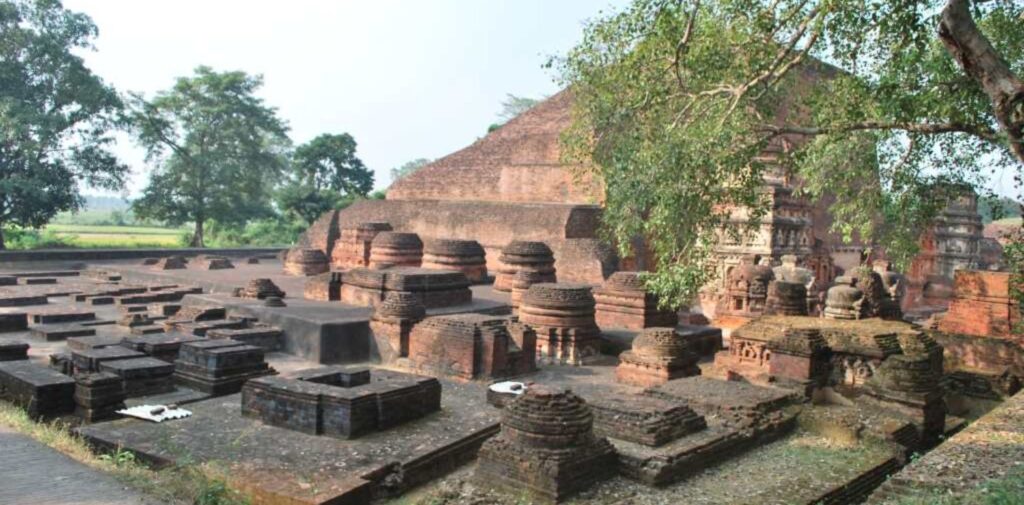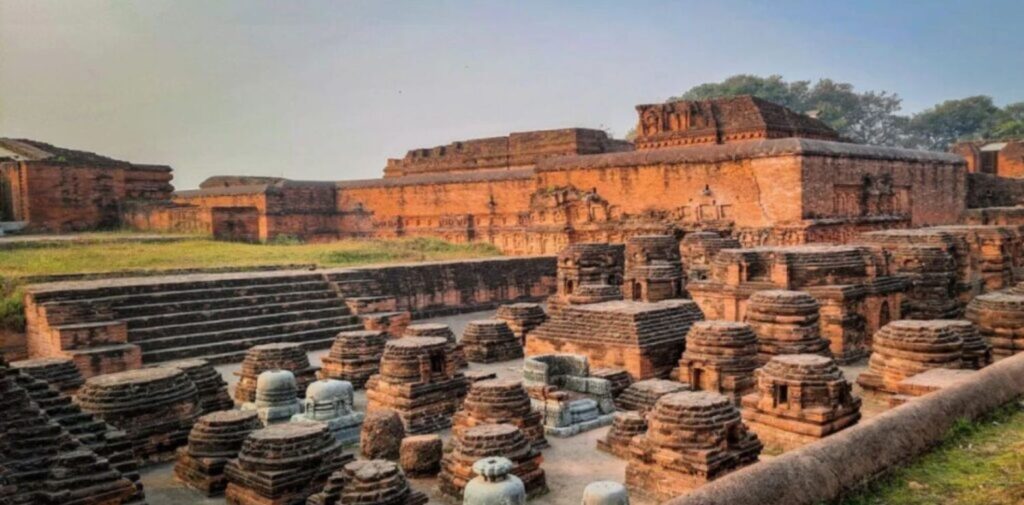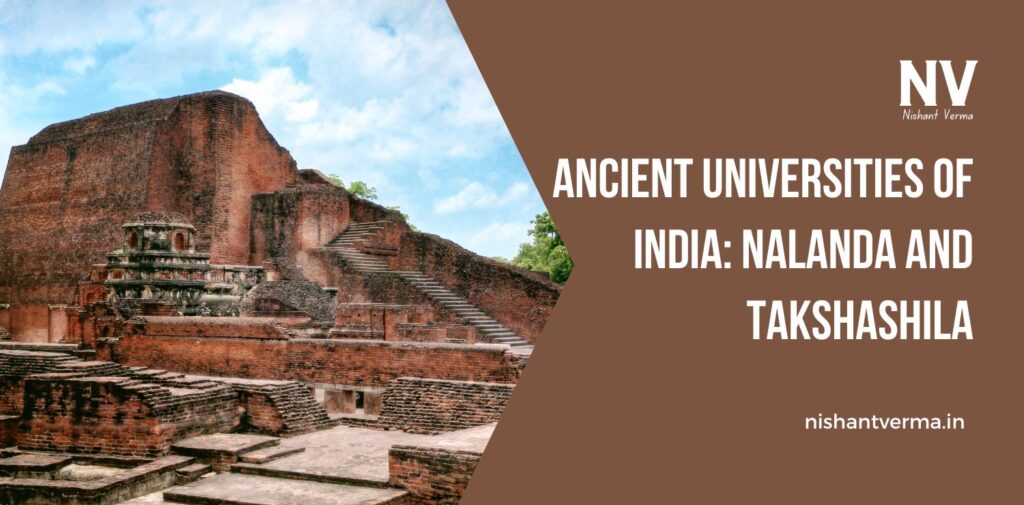India, with its rich and deep history, has always been a place of learning, wisdom, and knowledge. Thousands of years ago, there were ancient universities in India that were famous all around the world. Among these universities, two stand out the most: Nalanda and Takshashila. These institutions were the heart of learning, where students from far and wide came to study. Let’s take a closer look at these ancient centres of education and how they helped shape the history of India.
What Were Nalanda and Takshashila?
Nalanda and Takshashila were not just universities, but great centres where learning and knowledge flourished. These were places where the brightest minds came together to study different subjects, from philosophy to science, and from medicine to mathematics.
- Takshashila: Takshashila, one of the oldest known universities, was situated in present-day Pakistan, near the modern city of Rawalpindi. It was founded around 7000 years ago, during the time of the ancient Vedic civilization. It became a famous place of learning during the time of the Maurya dynasty.
- Nalanda: Nalanda University, on the other hand, was located in present-day Bihar, India. It was established in the 5th century CE by Kumaragupta I, the Gupta emperor. Nalanda became a world-renowned centre for Buddhist learning and attracted students from all over Asia.

What Did They Teach at These Universities?
Both Nalanda and Takshashila were universities that offered a wide range of subjects to study. These were not just places where children learned basic education, but centres for higher learning where scholars, teachers, and students came together to study serious topics.
Takshashila’s Subjects:
At Takshashila, the courses were broad and varied. The subjects included:
- Vedic Studies: Ancient Indian scriptures and religious texts.
- Astronomy and Mathematics: Understanding the stars, and planets, and solving complex mathematical problems.
- Medicine: Healing practices, surgery, and health care.
- Law and Governance: Learning about how societies and governments work.
Takshashila was famous for its diverse range of subjects, and it had teachers who were highly respected in their fields. People from different parts of the world, including China, Central Asia, and even Greece, came to Takshashila to study.
Nalanda’s Subjects:
Nalanda, being one of the largest and most prestigious universities of its time, offered more advanced courses, mainly focused on:
- Buddhist Philosophy: Nalanda was famous for Buddhist studies, and monks from across Asia came to learn Buddhist teachings.
- Logic and Debate: The scholars at Nalanda were trained in the art of reasoning and debating.
- Mathematics: Ancient Indian mathematics, including algebra, geometry, and even the concept of zero.
- Medicine and Surgery: Like Takshashila, Nalanda also focused on healing practices.
- Literature and Arts: Nalanda also had a deep focus on the arts, with literature and poetry being taught alongside other subjects.

Who Came to Study at Nalanda and Takshashila?
Both Nalanda and Takshashila were known far and wide, and students came from across the world to study there.
- Students at Takshashila: At Takshashila, students came from distant lands, such as China, Korea, Central Asia, and even Greece. They came to study the rich Vedic tradition, ancient texts, and sciences. Famous figures like Chanakya, the ancient Indian philosopher and teacher, studied and taught at Takshashila.
- Students at Nalanda: Nalanda, on the other hand, was a hub for Buddhist studies. Scholars and students from China, Korea, Japan, Tibet, and even Southeast Asia travelled to Nalanda to learn about Buddhism. Famous scholars such as Xuanzang, a Chinese traveller, studied at Nalanda and later wrote about its teachings and facilities.
What Made Nalanda and Takshashila Special?
Many things made both of these ancient universities stand out.
- Libraries and Knowledge: One of the key features that made Nalanda and Takshashila special was their huge libraries. Nalanda, for instance, had a library known as Dharmaganja, which was so large that it was said to have thousands of manuscripts and texts. Scholars from all over the world came to these libraries to read, learn, and teach.
- World-Class Teachers: Another important factor was the teachers. The teachers in both these universities were experts in their fields. They were not just normal professors, but philosophers, scientists, and great thinkers who contributed to the growth of human knowledge.
- Debates and Discussions: Both universities were known for their debates and discussions. Students didn’t just read books and memorize lessons. They had discussions and debates on various subjects, testing their knowledge, reasoning, and understanding. This made learning a very interactive process.
The Decline of Nalanda and Takshashila
Sadly, both Takshashila and Nalanda faced destruction and decline. The reasons were different for each of them.
- Decline of Takshashila: Takshashila, which was flourishing for over a thousand years, began to decline when the Huns (a nomadic group) attacked India. They destroyed many parts of the region, including the university. Although Takshashila continued to exist for some time, it never regained its former glory.
- Decline of Nalanda: Nalanda suffered a similar fate. In the 12th century, when the Turkish invader Bakhtiyar Khilji attacked India, he destroyed the university. The magnificent library was set on fire, and it is said that the flames from the burning library continued for months. After this attack, Nalanda never recovered, and it was lost to history.

Legacy of Ancient Universities of India Nalanda and Takshashila
Even though Nalanda and Takshashila were destroyed long ago, their legacy lives on. The universities played a key role in shaping the education system and culture of India. They promoted free-thinking, reasoning, and debate, which were important aspects of Indian education.
- Global Influence: The teachings from Nalanda and Takshashila spread across Asia, influencing countries like China, Japan, and Korea.
- Indian Knowledge: The ancient knowledge in fields like mathematics, astronomy, and medicine that was taught in these universities became the foundation for later advancements in these fields.
- Indian Culture: Both universities played a role in spreading Indian culture, philosophy, and religion across the world.
Conclusion
Nalanda and Takshashila were more than just universities. They were centres of knowledge, wisdom, and culture that helped India and the world grow in many fields. Their destruction was a huge loss, but their legacy remains in the form of the rich knowledge and teachings they passed on. Today, we continue to learn from the ancient wisdom that these universities left behind, and their stories remind us of the importance of learning, teaching, and sharing knowledge with the world.
In modern times, there is a growing effort to revive the spirit of Nalanda, with a new Nalanda University being established in Bihar. This shows that the importance of education, just like in the ancient days, continues to shape our future.
So, the next time you hear about Nalanda and Takshashila, remember that these universities were not just buildings filled with books, but places where the light of knowledge shone brightly, guiding people toward a brighter future.




